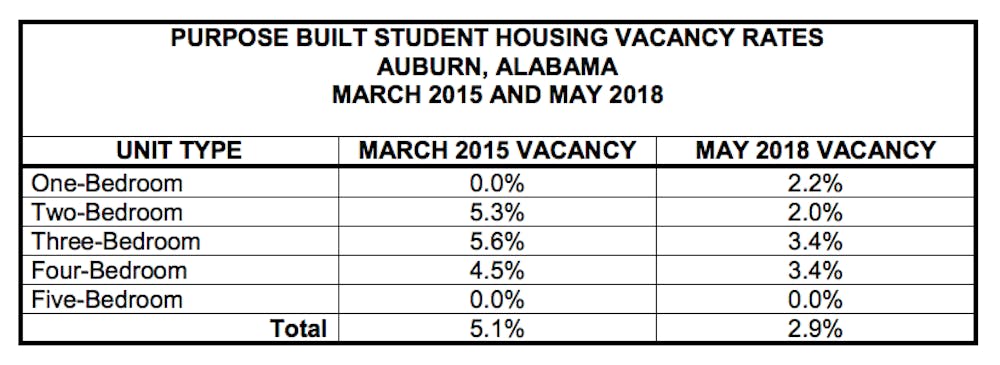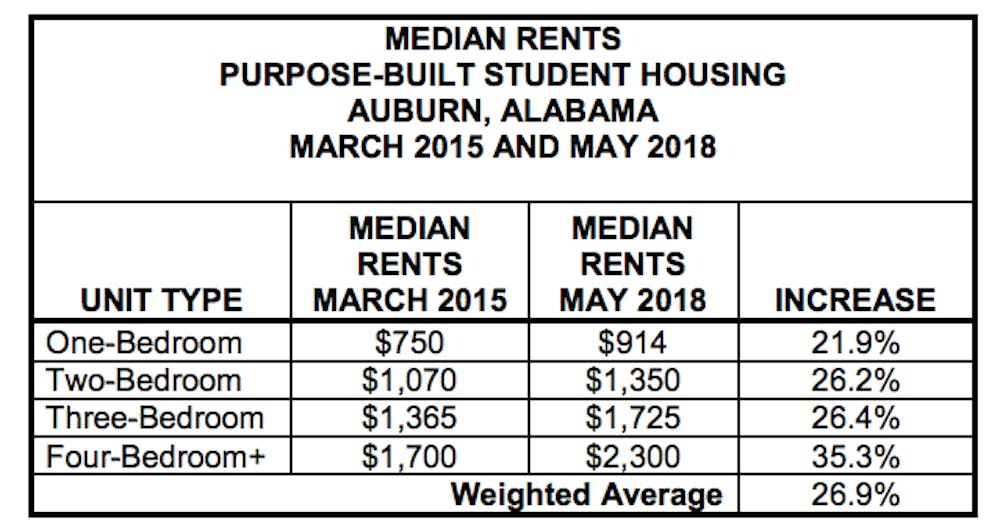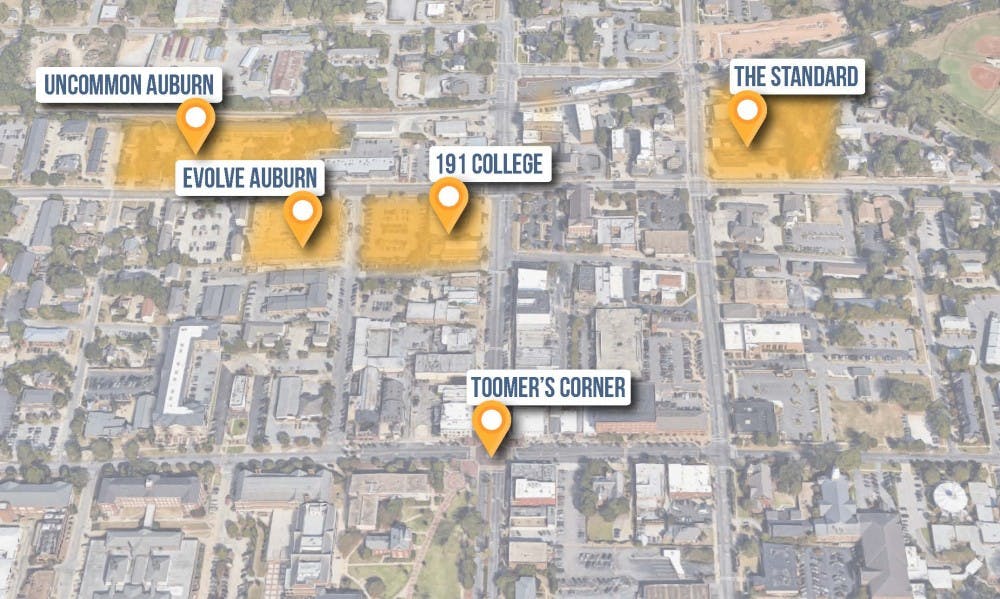Auburn needs more student housing within a walkable, 1-mile distance to campus in addition to the four student-housing developments underway, according to a recently released report from Danter and Associates.
The city initially commissioned Danter, a real estate consultant firm out of Columbus, Ohio, in 2012 for an initial student-housing study. Since then, the city has commissioned the consultant firm for report updates every three years.
The latest report was issued Oct. 5, 2018, and Assistant City Manager Kevin Cowper presented the report at Tuesday’s City Council meeting.
“It’s a starting point,” Anders said. “I still intend on appointing a student-housing task force that will be representative of our community.”
“At the end of the day, we’re going to have a philosophy as a city,” Anders said. “This is how we’re going to go forward with student housing.”
The study identified 18 purpose-built student housing complexes with a total of 3,190 units and 8,964 beds in Auburn. These complexes, such as Creekside of Auburn, are all privately constructed, owned and managed multifamily developments with individual leases and are typically furnished, according to the report.
The vacancy rate for the 18 purpose-built student housing complexes is 2.9 percent, which is down from 5.9 percent in 2015 and 8.1 percent in 2013. The newer properties, such as Evolve, have even lower vacancy rates.

“The 2.9 percent vacancy rate is considered extremely low and would indicate that the market is limited by a lack of supply, rather than lacking demand,” the report reads.
Rent has also increased over the last three years at an average annual rate of 8.3 percent. Part of this large rise is because of the addition of more high-end, purpose-built student housing such as Evolve or 160 Ross.
However, when those two properties are excluded, the average annual rate is 5.6 percent, which indicates strong overall growth in rental rates, the report said.
The overall conclusion from the report is there is a demand for purpose-built student housing, especially within a walkable, 1-mile distance from campus.
Danter’s formula for determining this is to take the total enrollment of the University and subtract the number of beds the University provides in on-campus housing.
Danter suggests the city have purpose-built student housing available to 50 percent of the remaining population of students that cannot be housed on campus.
For example, in 2018, the student enrollment is 30,440 with 4,725 beds available in on-campus housing.
That leaves 25,715 students that would need off-campus housing. Danter suggests that 50 percent, in this case 12,858 beds, be available in purpose-built student housing.
However, in 2018, Auburn only offers 8,964 beds in purpose-built student housing from 18 complexes leaving Auburn 3,894 beds shy of Danter’s suggested 50 percent.

“They said that is a conservative goal,” Cowper said. “There are communities that could be anywhere from 40-60 percent. Based on their knowledge of similar communities, similar student characteristics, that is the target for Auburn.”
The amount of purpose-built student housing Danter recommends is different for every University across the nation because it is based on factors such as where the campus is located and how many female and out-of-state students attend the university, Cowper said.
“One of the things I was trying to caution them (the Council) about was how quickly that housing is introduced into the market and how quickly it can be absorbed,” Cowper said. “The consultant recommends 400-450 units a year. So if you build one complex, that’s going to be 400 plus or minus units. If you build three or four in a year, then you’re introducing a lot of beds onto the market, and the market may not necessarily be able to absorb them that quickly.”
After the addition of two purpose-built student housing complexes in 2019 and another two in 2020, Auburn is offering 11,464 beds. That means Auburn is offering 44.6 percent of students purpose-built student housing.
This percentage is based on enrollment.
These numbers are unlikely to remain the same because Auburn has seen a steady rise in enrollment each year and is looking to replace The Hill dorms in the coming years, which would mean closing some on-campus housing in order to rebuild, according to Cowper’s presentation of Danter’s report.
These numbers indicate Auburn has a need for more purpose-built student housing.
However, adding too much purpose-built student housing at one time may not benefit the market. Slow integration of about 400-450 beds a year is better, Cowper said.
Purpose-built student housing is not the only type of housing offered to students off campus. The Danter report identifies these other types as conventional housing.
These include duplex developments, mobile homes, townhouses and other multi-bedroom units that typically rent by the unit rather than the bedroom.
The report identified a new type of housing that was unfamiliar to most of the Council called academic detached dwelling units. These are typically five-bedroom, five-bath units that have only begun popping up since the last report in 2015, Cowper said.
Many students’ parents will buy their student a condo or single-family home for them to live in.
This type of student housing and other non-purpose-built student housing need to be looked at, Anders said.
“Right now we don’t have a real philosophy, a real plan,” Anders said. “The city needs a plan when it comes to multi-family student housing.”
Do you like this story? The Plainsman doesn't accept money from tuition or student fees, and we don't charge a subscription fee. But you can donate to support The Plainsman.

Elizabeth, senior in journalism and political science, is the community editor for The Plainsman





